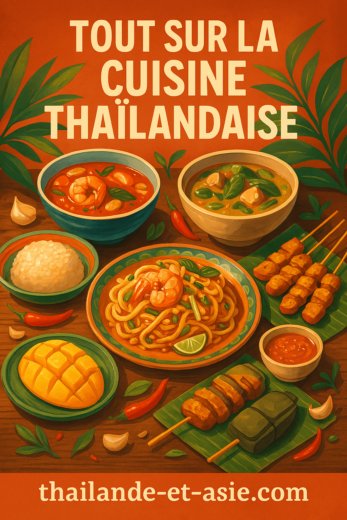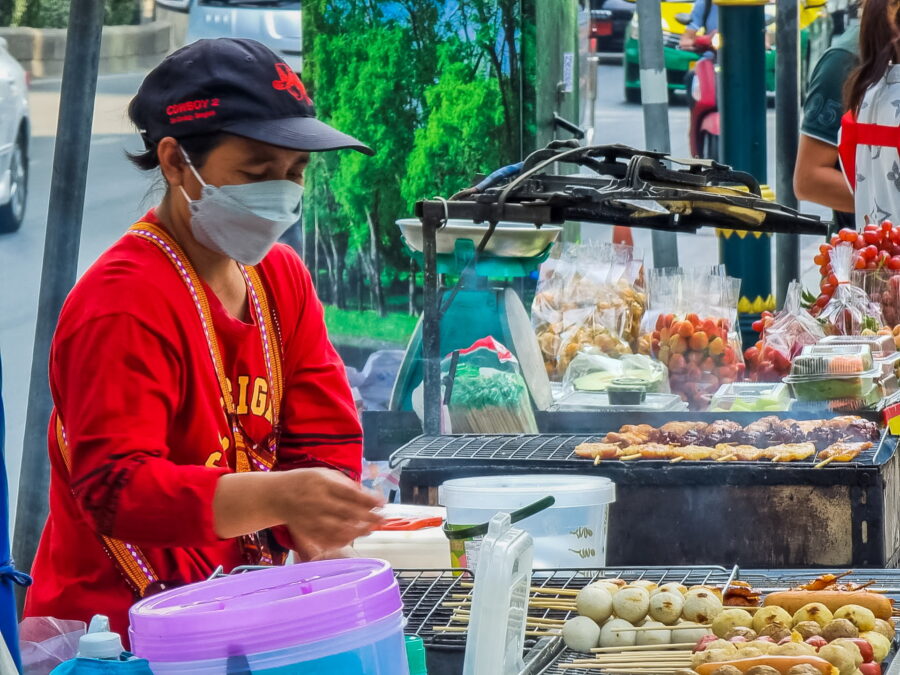It took more than 10 years for me to talk about cooking in Thailand. I did talk about my experiences in cooking classes (see the article here), but otherwise, I never took the time to dig into the subject... While frankly, if there's one thing you remember from a trip here, it's the food!
It's hard to escape: between the night markets, the small restaurants on the sidewalk and the regional specialties that change from one end of the country to the other, Eating in Thailand is an adventure in itself.
Why is Thai cuisine so fascinating?
- An explosion of flavors : sweet, salty, sour, spicy, it's all about balance, a clever mix that the Thais have mastered perfectly!
- Accessible to all budgets A good, simple dish can cost less than €2. From €5, you can enjoy a real feast.
- Infinite diversity : from the spicy curry of the South to the more subtle dishes of the North, each region has its treasures.
So, what are its specialties and must-try dishes? And above all, there's a mistake that (almost) all travelers make...
1️⃣ Pad Thai, really a must? Not so sure!
This is often the first Thai dish recommended to travelers. Easy to eat, not too spicy, accessible everywhere... Pad Thai has it all.
But is this really the best way to discover Thai cuisine? I want to bust a myth, as this dish is so popular all over the world.
Was it Pad Thai wasn't the tastiest dish? What if it was actually just a default choice, when Thailand is full of far more complex, fragrant and authentic dishes?
You should know that This dish was designed to represent Thailand. Unlike other regional specialties that have evolved naturally over the centuries, Pad Thai is actually a recent invention, popularized for a very specific purpose: create a national culinary identity.


In the 1930s-1940s, under the government of Prime Minister Plaek Phibunsongkhram, Thailand (still called the Kingdom of Siam at the time) sought to strengthen its national identity in the face of foreign influences. In this context, Pad Thai has been promoted as a symbol of the country, a way to differentiate Thai cuisine from other Asian cuisines.
But that's not all: there was also an economic reasonAt that time, rice production was a key component of the country's economy. Encouraging the consumption of rice noodles rather than whole grains helped boost Thai rice exports while diversifying the local diet.
This is how the government launched a campaign to promote Pad Thai, presenting it as a modern, easy to prepare and nutritious dish. This strategy worked: Pad Thai has become popular in Thailand… but also abroad, because he was less spicy and more accessible than many other Thai dishes.
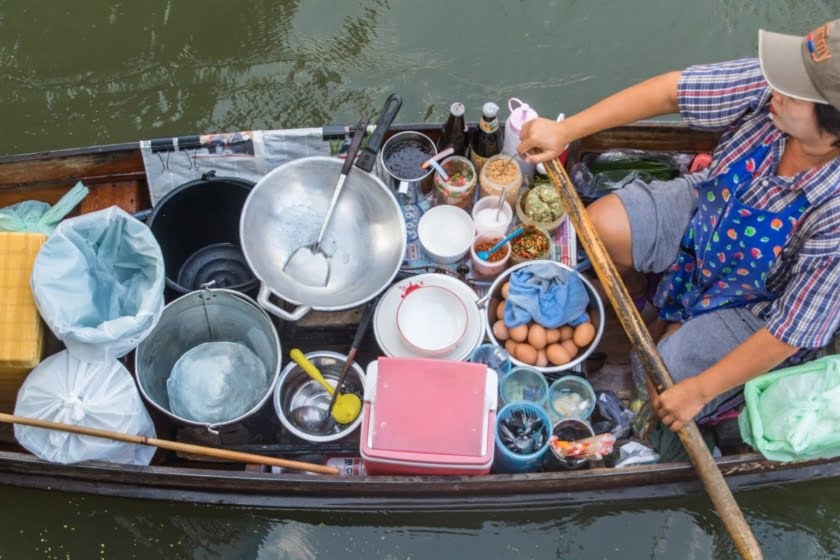
Today, Pad Thai is seen as THE iconic dish of Thailand, while it is far from being representative of real local cuisine. It is above all a successful marketing product., a dish that is very popular with tourists and has become a staple in Thai restaurants around the world. And paradoxically, Thais themselves actually eat very little of it.
Sure, it's possible to find a good Pad Thai, but if you want to discover the country's true culinary richness, don't stop there! There are much better options to try, with dishes that will truly take your taste buds on a journey.
Afterwards, I have to be honest: even if there are fortunately dishes that are not very spicy or not at all, it is better to have a minimum tolerance for "spicy" , that's the only way you can really get a taste of the local culinary diversity.
2️⃣ Understanding Thai cuisine: basics and influences
Thai cuisine was not developed in a vacuum. It is the result of multiple influences that have developed over the centuries, with cultural and commercial exchanges from neighboring countries and beyond.
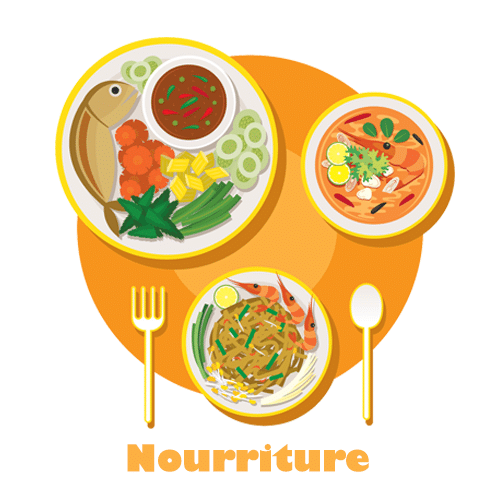
The major influences that shaped Thai cuisine
Here are the main influences found in many Thai dishes:
Chinese influence (probably the most visible)
China has had a huge impact, especially on street food and everyday dishes:
- Wok cooking, fried foods, quick stir-fries.
- Introduction of noodles, tofu, clear broths, noodle soups (Kuay Teow).
- Even dishes typically associated with Thailand such as Pad Thai or Pad see ew are, at their core, of Chinese inspiration.
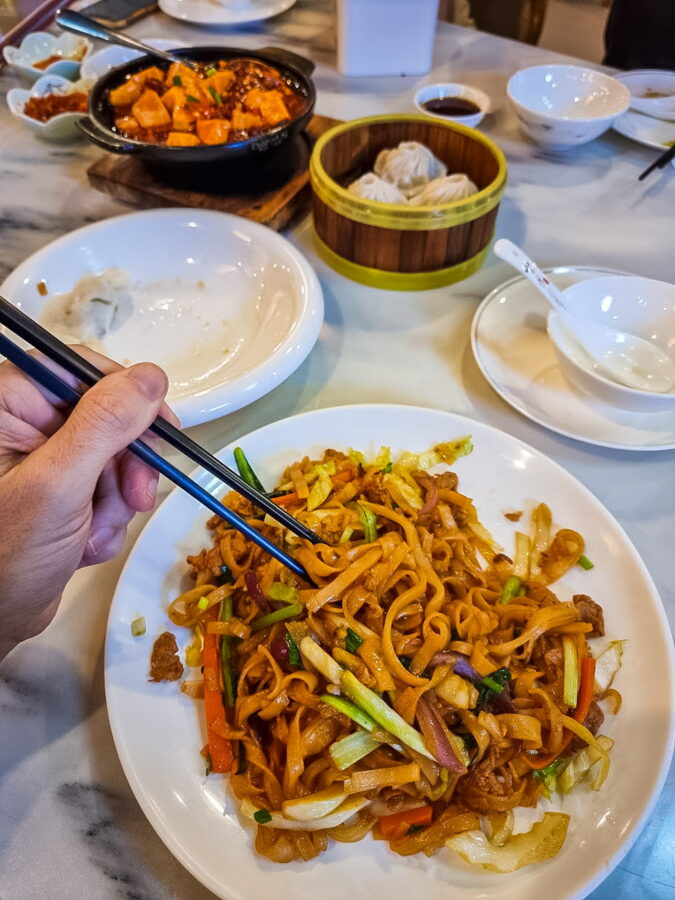
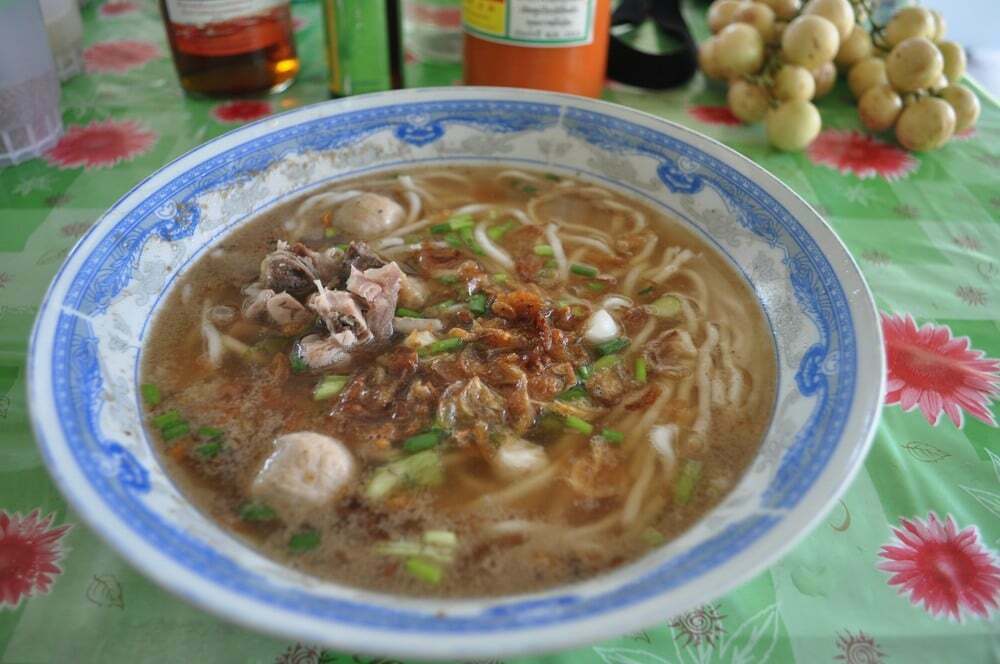
Indian and Persian influence
Less visible at first glance, but very present in the foundations:
- Use ofspices as the cardamom, cumin, clove, coriander or cannelle.
- Aromatic base of many Thai curries, then adapted with coconut milk and local herbs.
- Dishes like massaman curry or Khao mok gai (the local “biryani”) are its direct heirs.
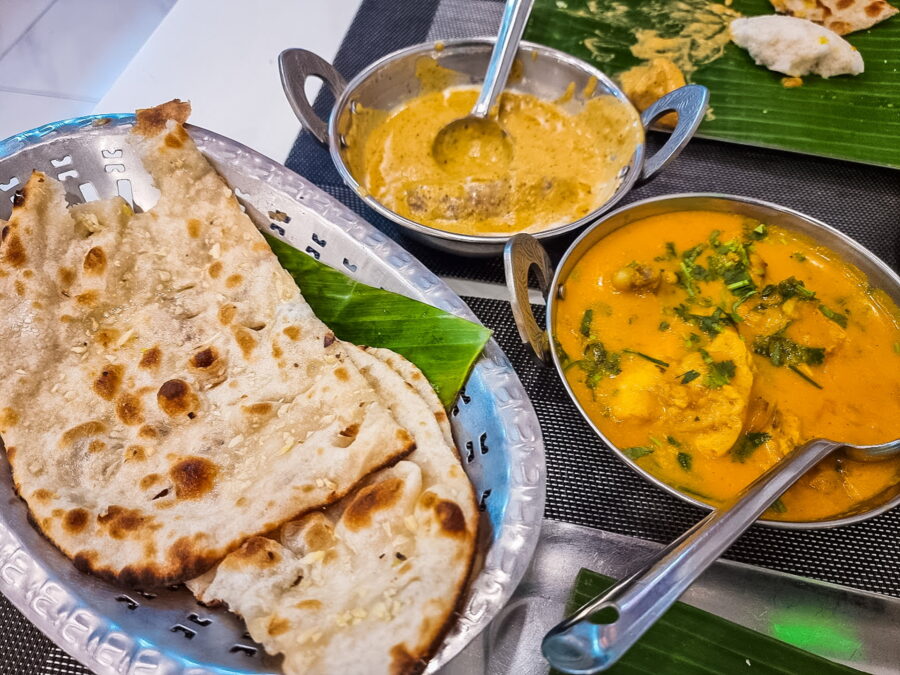
Malay and Muslim influence in the South
Particularly strong in the southern provinces:
- Contribution of the coconut milk, spicy curries, Satay skewers and its peanut sauce...
- Cuisine often more spicy, fragrant and rich in spices.

Burmese and Khmer influences
Less central, but present in certain regions or dishes:
- In the North part, the Burmese influence can be found in dishes such as Khao soi or Kaeng Hung Lay (mild curry of Burmese origin).
- As for khmer, some recipes based on shrimp pasta, fermented fish or sour vegetables bear witness to this cultural proximity, especially in the East of the country.
The Portuguese influence (less known, but very real)
When we talk about culinary influences in Thailand, we naturally think of those listed above. But The Portuguese also played a major role, and not just here.
It was they who, in the 16th century, would bring the pimento to Asia, via trade routes from South America. And it is this little ingredient, which has become indispensable today, which has literally revolutionized local cuisines!
Their influence is also found in some Thai egg yolk dessertsAs Foy Thong or Thong Yod, directly inspired by sweet and golden Portuguese delicacies. It is not uncommon to come across tarts in Thailand in the spirit of the famous Pasteis De Nata, it is not so much a “copy”, but rather a tasteful nod to this European influence.
Proof that travel leaves its mark in cuisine too. To learn more about this relationship between Siam and Portugal, I strongly recommend you explore the Sino-Portuguese neighborhood of Kudee Jin in Bangkok. There, you'll find a small café with a (free) museum upstairs. For more information, see my article here.

Key flavors: sweet, salty, sour, spicy
As I mentioned earlier, one of the secrets of Thai cuisine lies in the balance between these four flavorsThis is the very essence of what Thai cuisine represents. Here are the typical ingredients used to create these combinations:
- The sweet → palm sugar, coconut milk.
- The dirty → fish sauce (nam pla), soy sauce.
- Acid → lime, tamarind, rice vinegar.
- The spicy → fresh chilies, curry paste, galangal (a type of ginger).
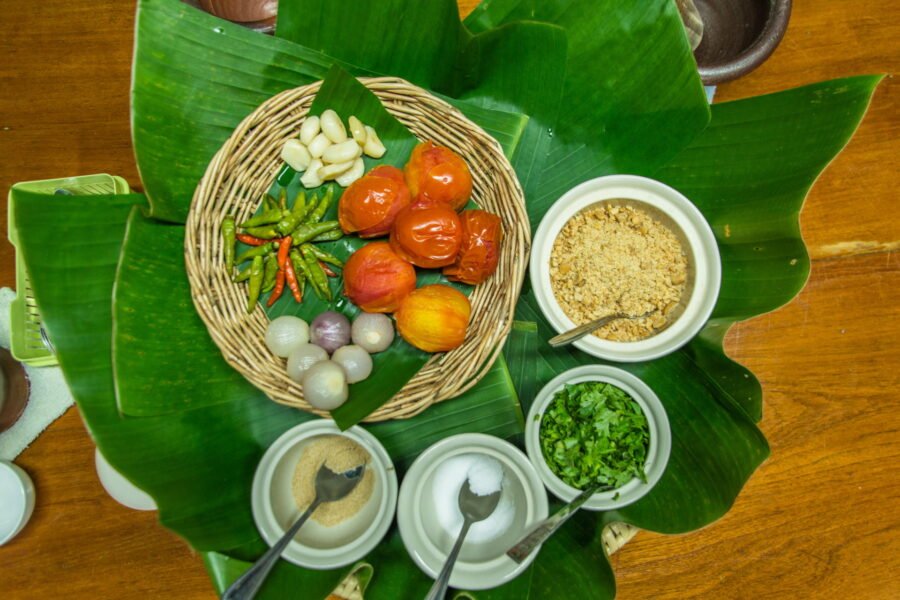
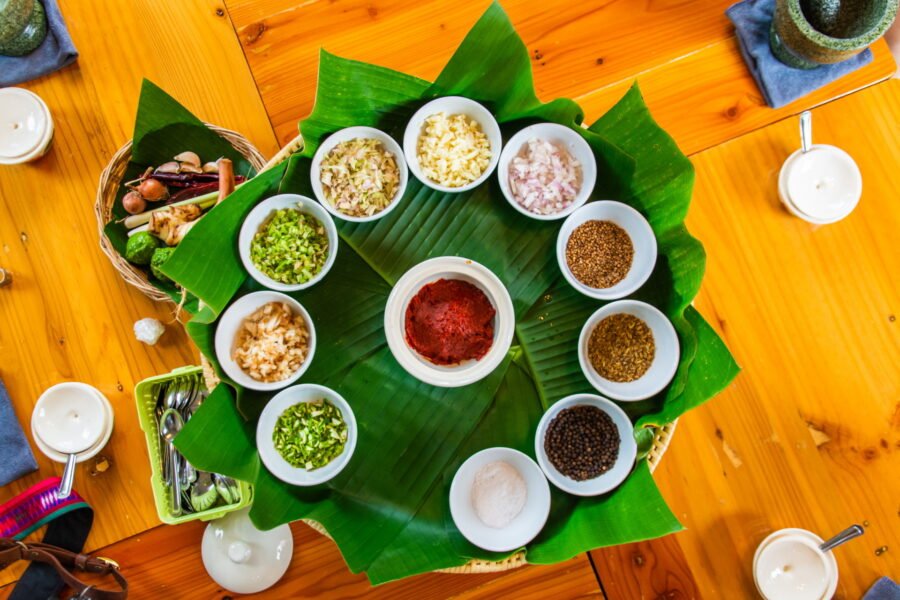
Rice and noodles: pillars of the Thai diet
Rice is the essential staple foodThere are two main varieties, which correspond to different uses:
- Jasmine rice (ข้าวหอมะลิ) → used in most everyday dishes.
- Sticky rice (sticky rice) → very common in the North and Northeast, often eaten with the fingers and accompanied by spicy dishes. It is also used in certain desserts.
When it comes to noodles, the Chinese heritage is evident. They are the basis of many popular dishes:
- Pad Thai → the famous one, with sautéed rice noodles, shrimp, tofu and peanuts.
- Pad see ew → flat noodles stir-fried in soy sauce, often with pork or chicken and some vegetables.
- Kuay Teow → A term of Hokkien origin designating flat noodles found in street soups, accompanied by a fragrant, sometimes spicy broth with pieces of meat and fresh herbs.
Meat and seafood in Thailand
In Thailand, pork and chicken are the most consumed meats on a daily basis. Beef, on the other hand, is much rarer., because it has never been a central ingredient in Thai culture. It is mostly found in Muslim restaurants or in some southern dishes.
Fish and seafood, on the other hand, are omnipresentShrimp, squid, crabs, whole grilled fish… they are found in curries, stir-fries, and soups, whether by the sea or in the city.
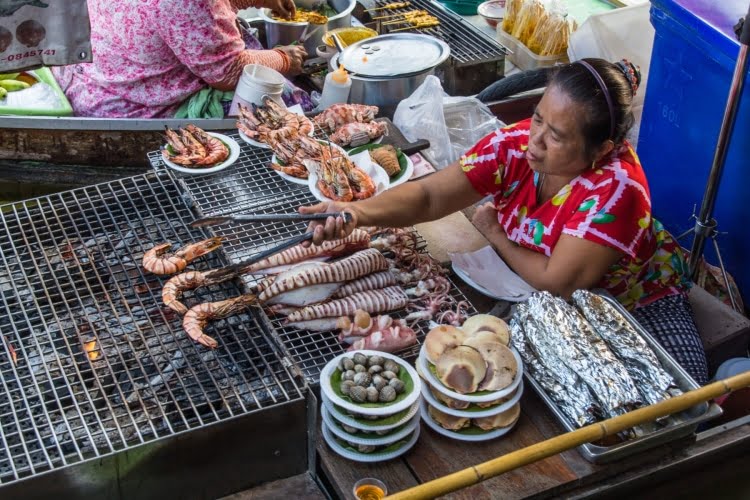
And for vegetarians?
The good news is that many dishes can be easily adapted. Often, it's as simple as removing the meat or opting for tofu.
- For example, one Khao Pad Khai (ข้าวผัดไข่) is a simple fried rice, only with egg.
- In vegetarian restaurants, fish sauce is often replaced with soy sauce.
- To identify vegetarian dishes, look for the yellow logo with the word "Jay" (Jay) : this means vegetarian/vegan in Thai.

3️⃣ Some essential and everyday dishes
While Pad Thai is often the first dish that comes to mind, as it is so widely promoted as a national dish, it is paradoxically far from being the most consumed dish in Thailand.
In everyday life, Thais favor simple, tasty, and quick-to-prepare dishes. They tend to be served quickly and don't usually linger at the table. These dishes are often enjoyed in small neighborhood restaurants or pre-prepared in a kind of street food court.

Another ubiquitous element in Thai cuisine: eggs. Whether in the form of Khai Dao (ไข่ดาว) – crispy fried egg, often added to a Pad Kra Pao, or Khai Jeow (ไข่เจียว) – ultra crispy Thai omelette, served with rice and chili sauce, eggs are a sure bet no matter the time of day.
The goal here is not to list everything (that would obviously take too long!) but to give an idea of the characteristic dishes of Thai cuisine and which are among my favorites (or almost).
Quick and essential everyday dishes
A bit like the local equivalent of fast food. Here are some of the must-sees you'll find. all over Thailand, from morning to night.
Pad Kra Pao (ผัดกะเพรา) – THE everyday dish
This is arguably one of the most ordered dishes in Thailand, even more so than Pad Thai. An explosive blend of holy basil (or tulsi), meat sautéed with garlic and chili, and optionally (but I recommend) a fried egg on top.
✅ Why is it a must?
- It's fast, cheap, and available everywhere.
- Holy basil brings a unique taste, not found elsewhere.
- Adaptable: you can order it with pork, chicken, beef, seafood, etc.
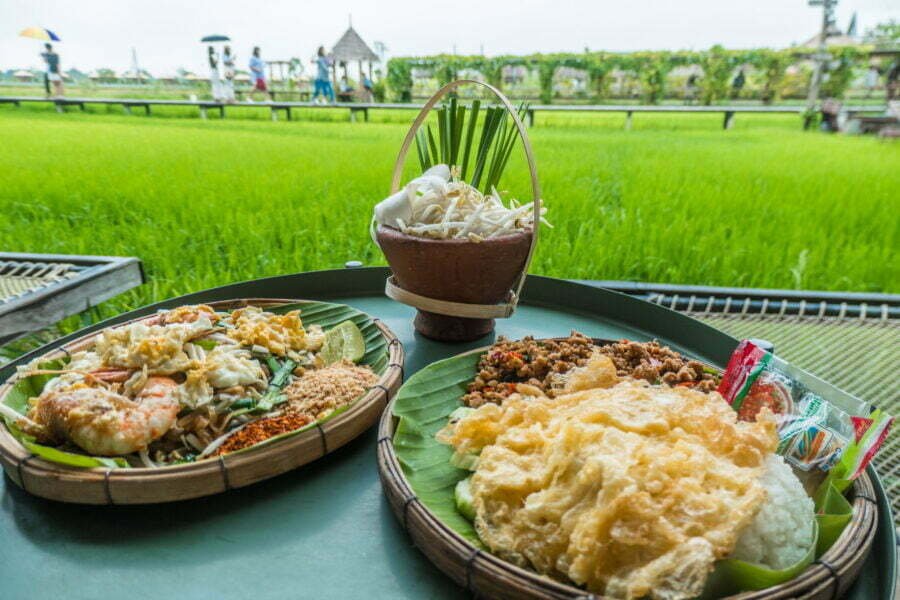
Khao Pad (ข้าวผัด>) – Thai fried rice
A simple but effective classic: wok-fried rice with eggs, vegetables, garlic, and a hint of fish sauce. You can add whatever you like: chicken, pork, shrimp, or crab. It's often served with a lime wedge and a few cucumber slices.
✅ Why is it a must?
- Easy to eat, without too strong a taste or harsh spices.
- Endlessly customizable: pork, chicken, shrimp, vegetarian…
- You can find them everywhere, from street stalls to more upscale restaurants.
Khao Man Gai (ข้าวมันไก่) – Thai version of chicken rice
A dish of Hainanese origin (Chinese island), but which has become a classic of Thai street foodPoached chicken served over rice cooked in a fragrant broth, accompanied by a spicy sauce made with garlic, chili and ginger.
✅ Why is it a must?
- A very simple dish, easy to digest and not spicy.
- Very common in small street restaurants.
- The key element? The sauce, which makes all the difference between a good and a bad Khao Man Gai.
More gourmet variant: Khao Moo Daeng (ข้าวหมูแดง)
If you are tempted by a visually more generous dish and you like slightly sweet flavors, try the Khao Moo Daeng, another great classic that is easily found in Thailand.
These books are thinly sliced roasted pork, served on white rice, topped with a sweet and savory sauce, often accompanied by a half a hard-boiled egg, and sometimes crispy pork (we are talking about Khao Moo Daeng Moo Krob).
A slightly more substantial dish, but just as popular as Khao Man Gai, especially in the food courts or small specialist shops.

Gai Yang (ไก่ย่าง) – Grilled chicken as you dream of it
Chicken marinated in a mixture of garlic, soy sauce, coriander, and spices, then grilled on the barbecue. It is usually served with sticky rice and a spicy sauce.
✅ Why is it a must?
- The sweet-salty-spicy combo of the marinade is just addictive.
- Perfect for a simple and effective meal.
- A great classic of Issan cuisine.
Khao Kha Moo (ข้าวขาหมู) – Ultra tender simmered pork
A dish very popular with Thais: pork braised for hours, served on fragrant rice with marinated vegetables and a soft-boiled egg.
✅ Why is it a must?
- The meat is ultra tender, full of flavor.
- The mixture with the pickled vegetables balances the dish perfectly.
- Very popular in street food, especially in markets.
The dish is usually prepared in advance and kept warm in a large pot, making it a classic street canteens to day markets : perfect for eating quickly and well.
⚠ A little personal aside: this isn't a dish I usually order, as I'm not a fan of pig's trotters, the central ingredient. But I'm listing it because it remains a staple for many Thais.. All in all, if you like this kind of stew, it might be worth trying!
Curries
Thai curries are among the richest dishes in flavorThey are prepared from curry pastes, a blend of spices, chilies, herbs, and aromatics ground together, which gives each curry its unique character. Depending on the quantity and type of chili used, some are milder, others very hot.
A disadvantage: as these pastas are often prepared in advance, it is more difficult to request a “non-spicy” version on order.
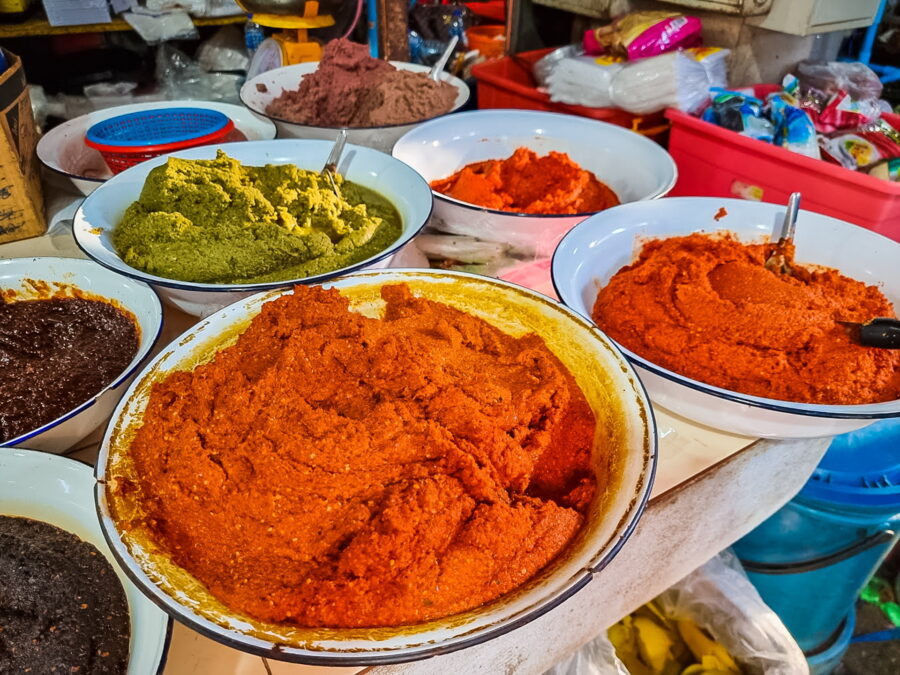
Gaeng Massaman (แกงมัสมั่น) – The mildest and fragrant curry
A curry inspired by Muslim cuisine, with a base of warm spices, coconut milk and (rare in Thailand) potatoes. Often served with beef or chicken.
✅ Why is it a must?
- Unlike most Thai curries, it is milder and has a slight hint of sweetness.
- The blend of spices (cinnamon, cardamom, star anise, etc.) gives it a unique aroma.
- Ideal if you want to try a curry without ending up in tears.
For the record : CNN Travel published an article titled "The World's 50 Best Foods," with massaman declared as "the most delicious dish ever created."
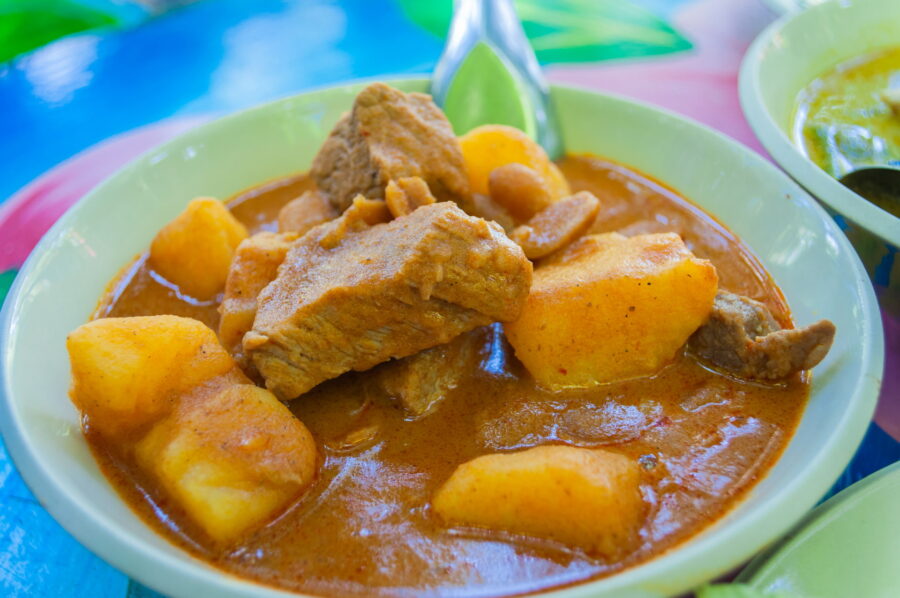
Gaeng Keow Wan (แกงเขียวหวาน) – Spicy green curry
An ultra-fragrant curry made with coconut milk, green curry paste, and Thai basil. A perfect balance between freshness and power of spices.
✅ Why is it a must?
- A good level of spice, but not overwhelming if you're used to it.
- Its intense color and aroma make it a very appetizing dish.
Panang (พะแนง) – Mild and creamy curry
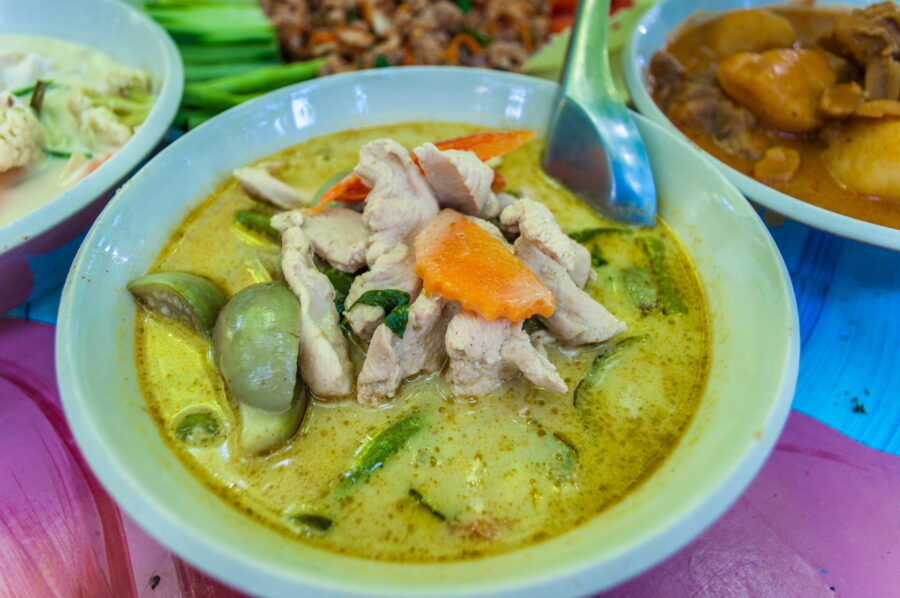
A thicker curry than the others, often slightly sweet, prepared with coconut milk, ground peanuts, and a reworked red curry paste. It is often served with beef or chicken.
✅ Why is it a must?
- Less liquid and creamier than other curries.
- Very fragrant, but generally not very spicy.
- Its texture and sweet-salty taste make it an excellent gateway to the world of Thai curries.
Street food and snacks
In Thailand, you can literally eat on the streets from morning to night. And while street food allows you to enjoy complete meals at low prices, it also offers a whole host of salty or sweet snacks, perfect for snacking between visits or with a cold beer.
These are often simple bites, easy to eat on the go, and found almost everywhere: markets, busy streets, food trucks or even on the back of a scooter (well, I'll avoid that!).
Here are some classics that I recommend you try:
Moo Ping (หมูปิ้ง) – Marinated pork skewers
A classic Thai street food dish, simple but effective: marinated pork skewers, grilled over charcoal and often served with sticky rice.
✅ Why is it a must?
- A slightly sweet and caramelized taste thanks to the marinade.
- Super convenient to eat on the go.
- Available all over, even from breakfast.
Gai Tod (ไก่ทอด) – Thai fried chicken
The chicken is marinated with garlic, pepper, and fish sauce before being deep-fried. The result: crispy skin and juicy meat inside.
✅ Why is it a must?
- A much tastier version than classic fried chicken.
- The marinade adds an ultra-addictive sweet and salty touch.
- Enjoy with sticky rice and a spicy sauce for a perfect combo.
Kanom Jeeb (ขนมจีบ) & Salapao (ซาลาเปา) – Thai dim sum
Directly inspired by Chinese cuisine, these two steamed snacks are among the classics found in markets or small morning stalls.
Kanom Jeeb, these are small steamed ravioli (shumai style), filled with pork, shrimp or sometimes mushrooms, served with a slightly sweet soy sauce.
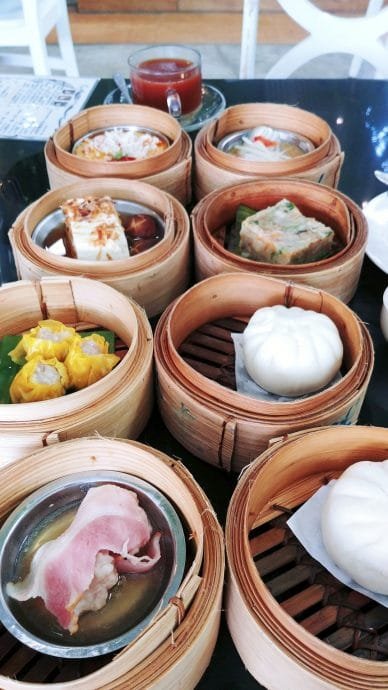
Salapao, these are steamed white buns, often filled with roasted pork, sweet red bean paste or even cream.
✅ Why is it a must?
- A nice alternative to the usual kebabs or fried foods.
- Kanom jeeb is light, tasty, with a soft texture and a well-flavored stuffing.
- Salapao is perfect for takeout, ideal for breakfast on the go or a sweet or savory snack. You can even find them in 7-11s!
Kluay Tod (กล้วยทอด) – Ultra crispy fried bananas
Although it could fall under the dessert category, it's actually a snack in its own right, something you can munch on at any time of day. Thai fried bananas are sweet and crispy on the outside, but still soft inside.
The batter that coats it is made from flour, grated coconut, and sometimes sesame seeds, which gives it a creamy and very delicious touch. Vendors often offer other variations, such as tapioca or fried taro.
✅ Why is it a must?
- A perfect texture: crunchy on the outside, melting on the inside.
- Cheap, easy to snack on the street.
- Eaten hot, a real treat when it's fresh out of the oil!
Fresh Fruits – An Ultra Refreshing Snack
It's impossible to talk about Thailand without mentioning its fruits! Throughout the country, you'll find stalls selling fresh fruit, either pre-cut or prepared to order, ready to be enjoyed. One of the most popular is the small Thai pineapple, which is incredibly fragrant and lacks the large, fibrous stem in the center.
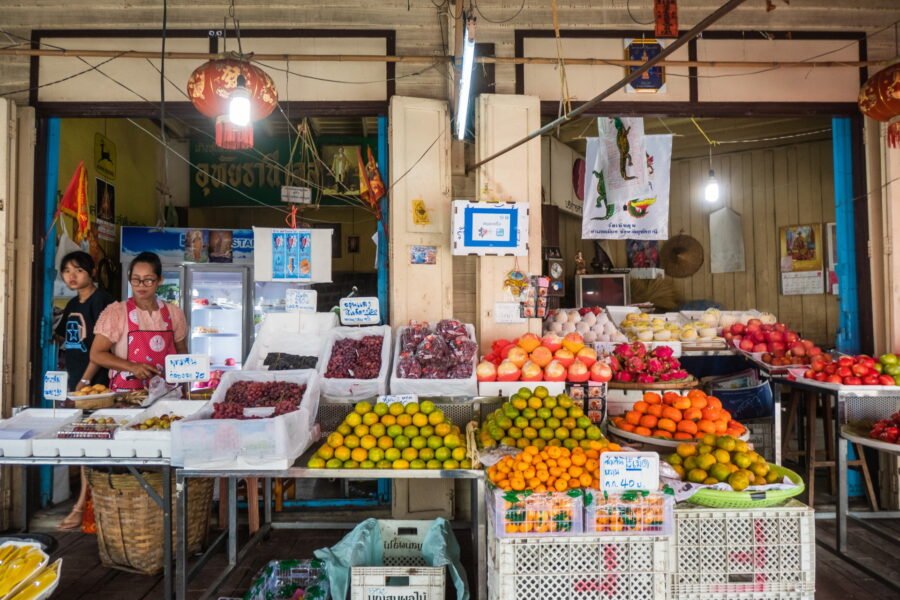
Sure, they could be classified as "dessert," but here, they're snacked on at any time of day. They're considered more of a snack than a way to end a meal.
✅ Why is it a must?
- A burst of freshness in the Thai heat.
- Already cut and ready to eat, often served with a small sachet of chili sugar.
- A light and natural alternative to fried snacks.
Soups and comfort food
Thai soups aren't just starters: they're dishes in their own right, often rich in flavors and ingredients. In fact, they shouldn't be seen as a "soup" from our country, or you'll be mistaken for a hot winter dish that's not suited to a tropical country...
Tell yourself that it's more of a meat or fish dish with a generous sauce! Some, like the Tom yum, are powerful and spicy, while others, like the Tom Kha, offer softer and comforting notes thanks to coconut milk.
Tom Yum Goong (ต้มยำกุ้ง) – The spicy soup that wakes you up
One of the most famous soups in the country, made with lemongrass, galangal, chili peppers and shrimp (in its most classic version, but also available with other meats, more typically chicken or fish).
✅ Why is it a must?
- A powerful blend of acidity and spiciness.
- A true concentrate of Thai flavors.
- A culinary discovery that left its mark on me!
Tom Kha Kai (ต้มข่าไก่) – Chicken in coconut milk
A milder soup than Tom Yum, made with coconut milk, lemongrass, and galangal, with tender pieces of chicken. Some versions also include tomato chunks.
✅ Why is it a must?
- Less spicy than Tom Yum, perfect for those who want balanced flavors.
- A subtle blend of the sweetness of coconut milk and the acidity of lime.
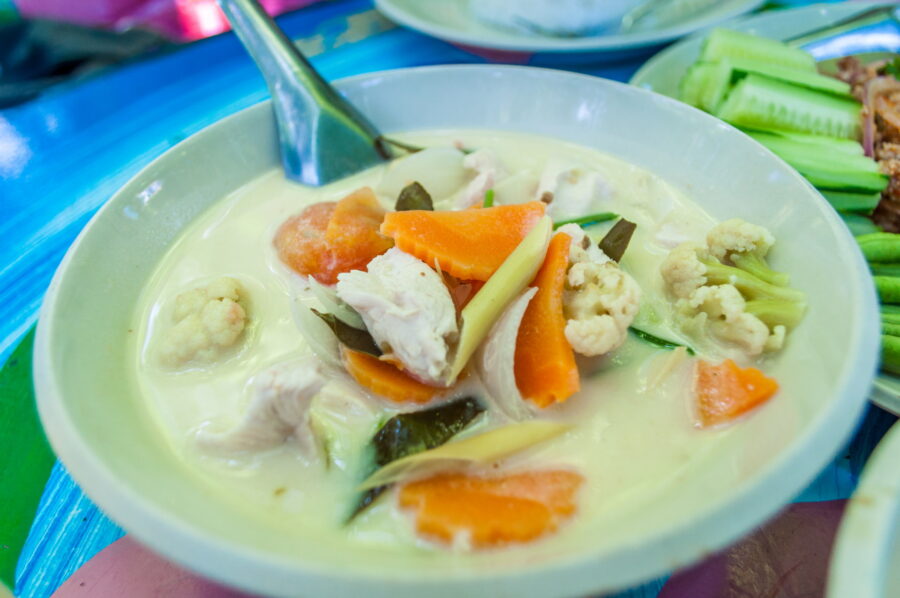
Salads and fresh dishes
In Thailand, the term s doesn't necessarily mean a light and mild dish – and certainly not our Western-style green salads. At least, not by default.
On the contrary, Thai salads are often very spicy and well-seasoned, with a nice balance of flavors: sour, salty, sweet, and often very spicy. While Som Tam (green papaya salad) is the most well-known, another must-have is Larb, which is found throughout the country.
Som Tam (ส้มตำ) – The essential green papaya salad
A great classic from Issan, made with grated green papaya, chili, lime, fish sauce and sometimes a few peanuts or mini crabs.
✅ Why is it a must?
- A fresh, spicy and ultra addictive dish.
- Perfect for balancing a rich meal.
- Available in several versions depending on taste (more or less spicy, with or without sugar, with peanuts or fermented fish).
Larb (ลาบ) – Minced meat salad
Originating from Northeast Thailand (and Laos originally), Larb is a warm salad made with minced meat (often pork or chicken), lime, fish sauce, fresh herbs and toasted rice powder.
✅ Why is it a must?
- Intense and tangy flavor, with a little crunch thanks to the toasted rice.
- Perfect with sticky rice to calm the chili.
- A very popular dish, it is easy to find in restaurants and night markets.
- Available in several versions, but the best for me remains the Larb Moo (with pork), and more specifically the meatball version.
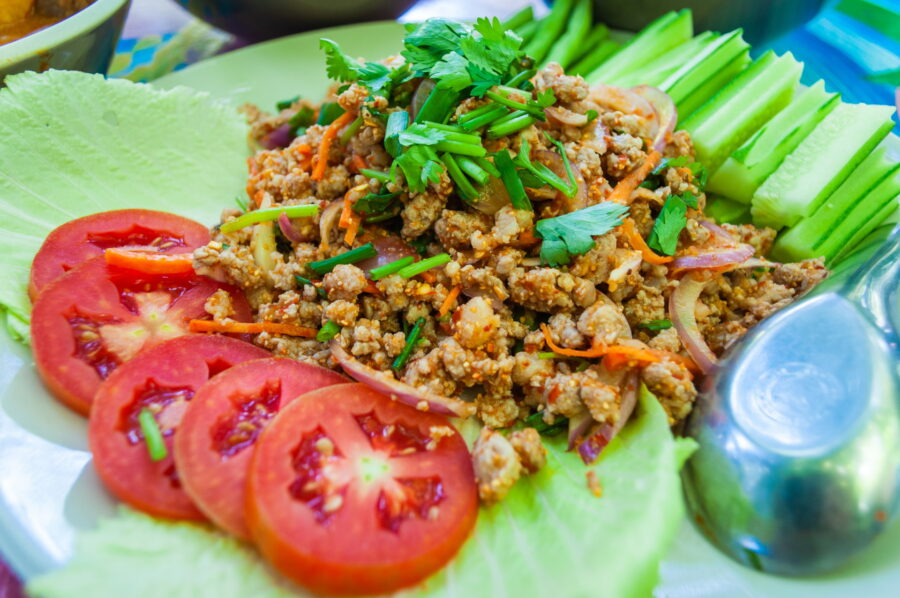
In addition to I'm there et larb, I must mention the other types of salads called yam (ยำ), prepared with meat, seafood, or even fried eggs. They are characterized by a very tangy sauce, often very spicy, made with lime, fish sauce, sugar, and chili. But my favorite remains the simple one with egg:
Yam Khai Dao (ยำไข่ดาว) – Fried egg salad
A delicious dish made with crispy fried eggs, sliced and tossed with onions, fresh herbs, chili pepper, fish sauce and lime juice.
✅ Why is it a must?
- A perfect balance between crispness, acidity and spiciness.
- A simple, original dish that is often overlooked by travelers.
- Perfect to accompany white rice or to eat on its own for a light meal.
Thai desserts and sweets
In my eyes and with a few exceptions, Desserts are not the strong point of Thai cuisine.Many are made with sticky rice, coconut milk, or crushed ice with sweet seeds and beans, which is unappealing at first.
Some, like the famous Mango Sticky Rice or Wheels Banana, are very popular (including among travelers), but others, more typically Thai, remain especially appreciated by locals.
Khao Niew Mamuang (ข้าวเหนียวมะม่วง) – Mango Sticky Rice
The quintessential Thai dessert: sweet sticky rice topped with coconut milk, served with a ripe mango, sometimes with sesame seeds.
✅ Why is it a must?
- The perfect combination of sweetness and the soft texture of rice.
- A simple, but effective dessert.
- Best during mango season in Thailand (March to May).
Kanom Krok (ขนมครก) – Ultra addictive little coconut pancakes
These small, soft and crispy Thai pancakes are prepared from coconut milk and rice flourThey are baked in special cast iron molds, which gives them their round shape and perfect texture.
✅ Why is it a must?
- A deliciously sweet and slightly salty taste.
- Soft on the inside, crispy on the outside.
- Perfect as a sweet snack or dessert.
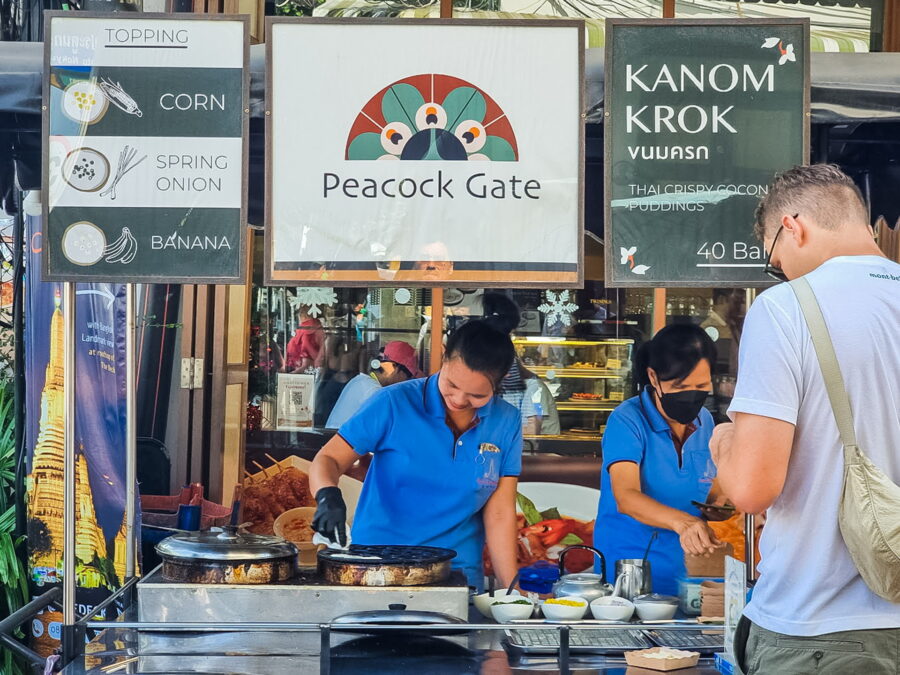
Thailand also has its own little crepe-style specialties, often sold on the street and perfect for a sweet (or even savory, depending on the variation) snack. Here are three classics you'll find everywhere:
Kanom Tokyo (tokyo snacks) – Thin and filled version
An alternative to kanom krok, these are very thin, rolled mini-crepes, mostly found in markets. They are filled with a sweet pastry cream, sometimes replaced with ground pork or a mini-sausage.
✅ Why test?
- Light and crispy texture
- Sweet or savory choice
- Mini size, perfect for nibbling while walking
Roti Gluay (โรตี) – Thai banana pancake
Of Muslim origin, roti is a thin, crispy pancake, prepared on a hot griddle. My favorite version? Topped with banana. et egg. Yes, I know, the mix may seem counterintuitive… but trust me!
The whole thing is then drizzled with sweetened condensed milk and sometimes sprinkled with sugar or chocolate (or even Nutella for those with a sweet tooth).
✅ Why is it a must?
- A pure delight, crispy on the outside and soft on the inside.
- Prepared on the spot, with quick and precise movements, it's a real little spectacle to see on street stalls.
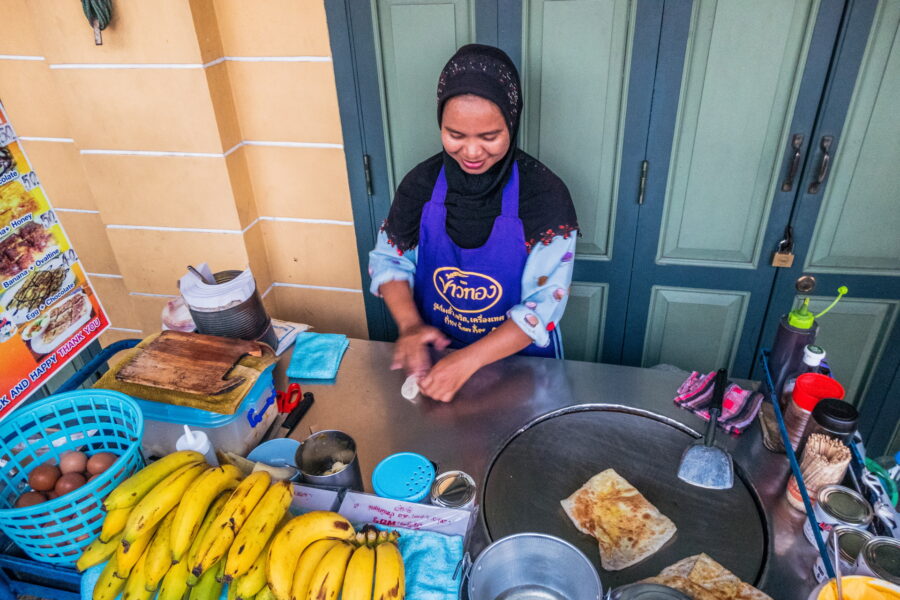
Tub Tim Krob (ทับทิมกรอบ) – The typical dessert
I'm putting it last because it's a dessert that doesn't appeal to me at all... But then again, it's one of the country's classics. If you come across a stand or restaurant offering colorful scoops served on crushed ice, well, that's it!
Composed of base by water chestnuts coated in tapioca flour, served in sweetened coconut milk and therefore crushed ice. Its name literally means “crunchy rubies,” due to the red color of the chestnuts.
✅ Why is it a must?
- Ideal in very hot weather, ultra refreshing.
- A unique texture, between crunchy and soft.
- Less well known than Mango Sticky Rice, but just as delicious.
4️⃣ What specialties are there depending on the region?
Each region of Thailand has his own specialties, influenced by history, climate and proximity to neighboring countries. Here are the must-try dishes to discover by region !
Northern Thailand: between Burmese influences and sweet flavors
In cities like Chiang Mai, Chiang Rai, or Mae Hong Son, the cuisine is less sweet and often a little less spicy than elsewhere. There are plenty of herbs, simmered or grilled dishes, and clearly visible Burmese influences.
- Khao soi
- Sai Ua
- Nam Prik Ong
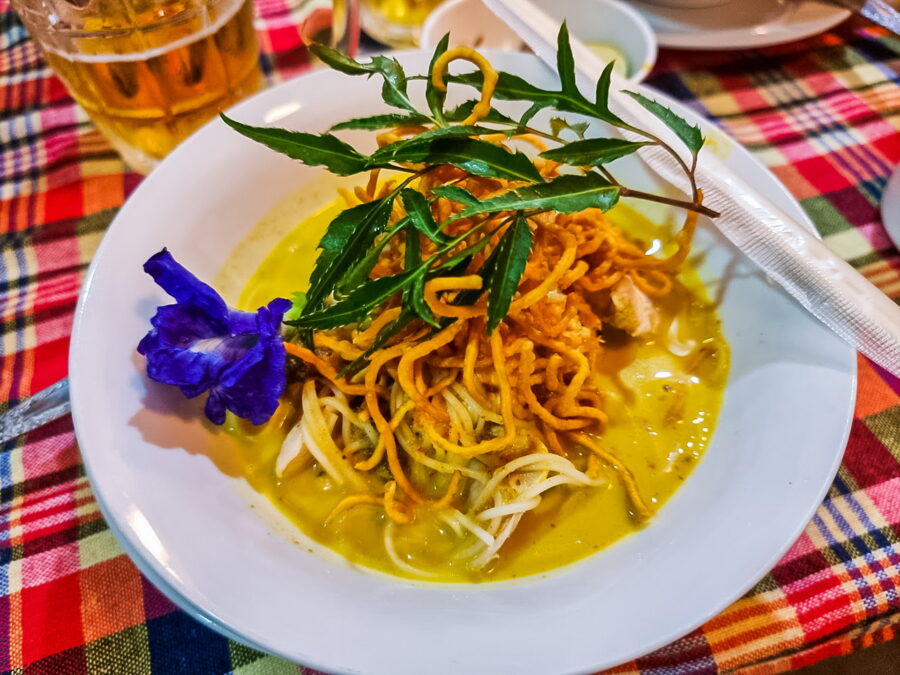
Issan (Northeast): the most explosive
The Issan region, bordering Laos, is renowned for its straightforward and spicy cuisine. Sticky rice, spicy salads, grilled meats... it's a simple yet characterful cuisine.
- Som Tam
- larb
- Gai Yang
Central Thailand: Balance and Variety
The center of the country (Bangkok, Ayutthaya, etc.) offers a more balanced cuisine, where the four flavors blend perfectly. This is where you'll find some so-called "royal" dishes, which are more refined and often made with coconut milk.
- Pad Kra Pao
- Tom yum goong
- Gaeng Keow Wan (green curry)
Southern Thailand: character and spice
The South (Phuket, Krabi, Hat Yai…) is influenced by Malaysia and India. Lots of dishes based on coconut milk, turmeric, seafood… and very bold flavors!
- Massaman curry
- Pla Tod Kamin (turmeric fried fish)
- Khanom Jeen Nam Ya
5️⃣ Street food, local restaurants or fine dining?
In Thailand, where you eat is almost as important as what you eat. The dining experience isn't just about what's on the plate: the ambiance, the setting, and the way the food is prepared all play a vital role.
Whether you're a street food lover, a fan of small local restaurants, or curious to try refined Thai cuisine, each option offers a different take on the country's gastronomy.
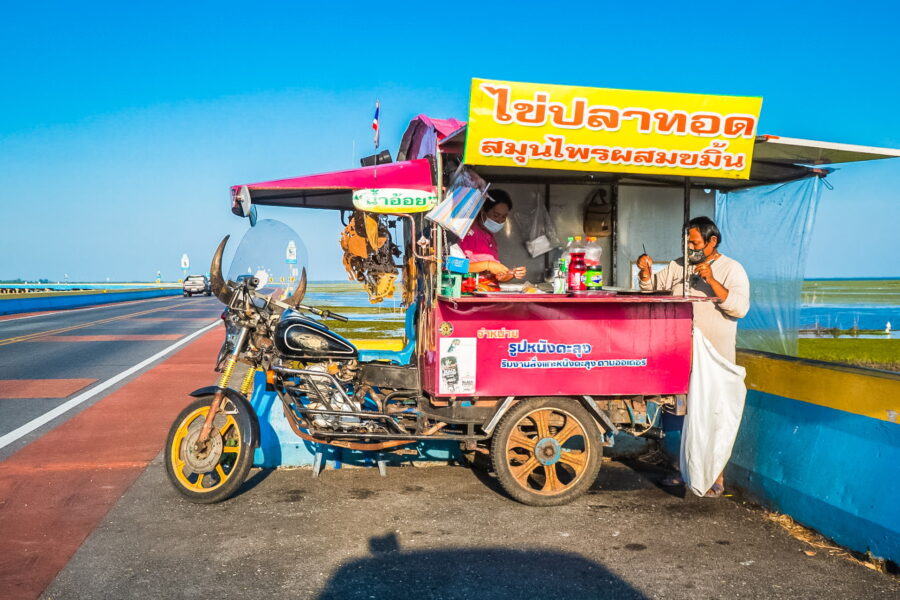
Street food: the best immersion in Thai cuisine
Whether in night markets or on the roadside, street food is the soul of Thai cuisine. Here, no fuss, fair tasty dishes prepared before your eyes, at unbeatable prices.
➡ Why test?
✔ Fast, cheap and authentic.
✔ Allows you to taste lots of different dishes without blowing its budget.
✔ A unique atmosphere, especially in the night markets.
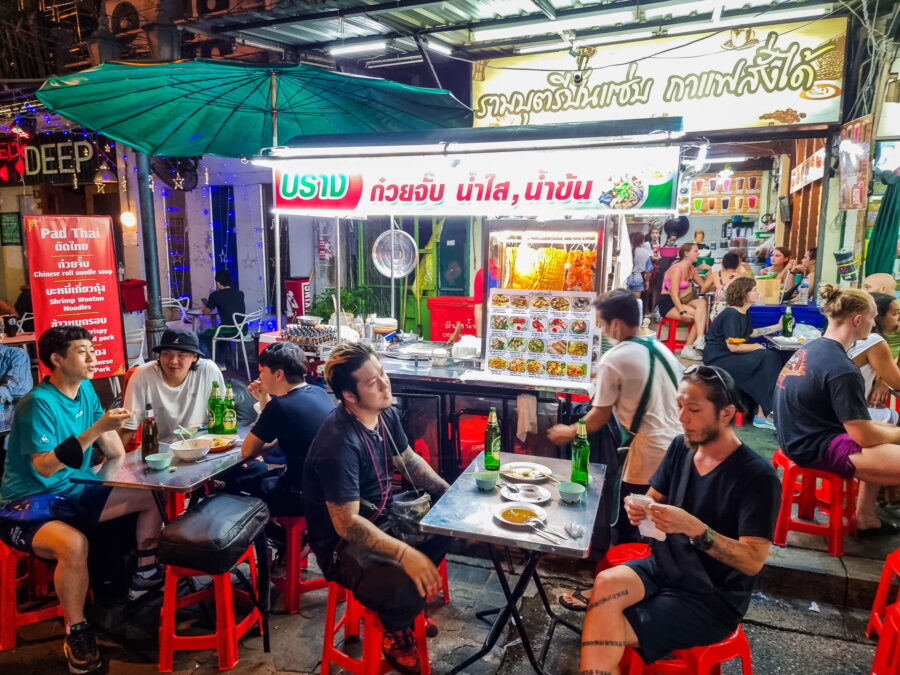
Local restaurants: the perfect compromise between comfort and authenticity
Between street food and high-end restaurants, small local restaurants are often the best places to discover well-prepared traditional dishes, in a simple but pleasant setting.
➡ Why test?
✔ A kitchen often more careful than in street food.
✔ Perfect for testing dishes requiring more preparation (curries, soups, etc.).
✔ Still cheap, with a little more comfort.
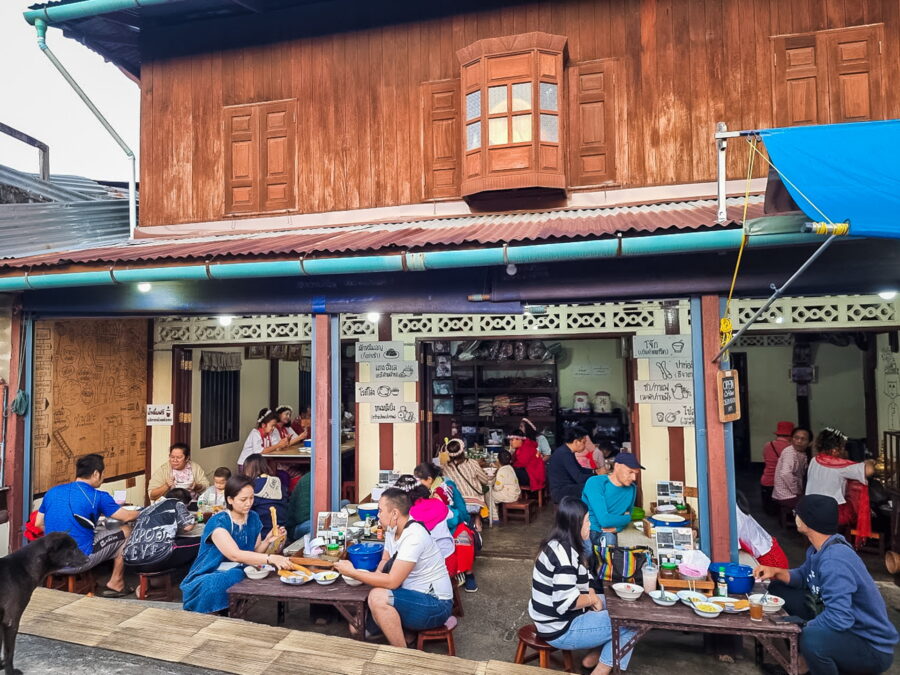
Refined cuisine: a more modern and sophisticated approach
Some Thai restaurants are banking on a more elegant version of traditional dishes, with a focus on more complex ingredients and cooking techniques.
➡ Why test?
✔ A more gastronomic experience, with a real enhancement of flavors.
✔ Ideal for discovering a different Thai cuisine street food.
✔ Many high-end restaurants use recipes inspired by royal Thai cuisine.
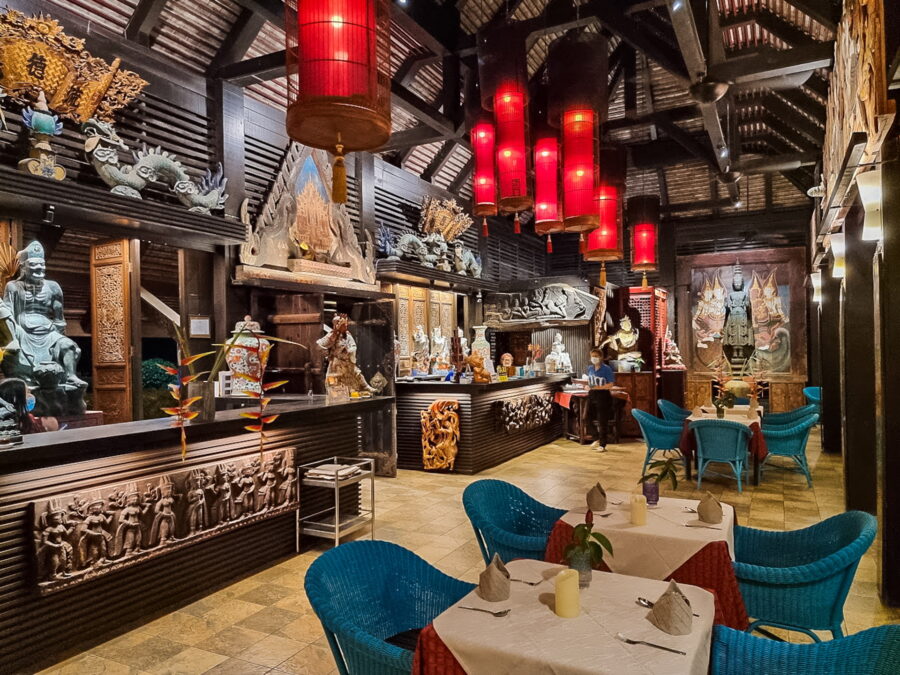
6️⃣ Some good addresses in Thailand
If you're looking for places to try some of the best dishes mentioned above, here are a few ideas. This isn't an exhaustive list, but rather a few favorites or iconic spots to try... if the opportunity arises!
These places are worth trying if you happen to come across them, but don't hesitate to try something new. In Thailand, the best surprise is often found where you least expect it.
Bangkok
Street food
• Yaowarat (Chinatown) → An essential reference, especially in the evening.
• Maha Chai Road (near Wat Saket) → Local atmosphere, good stir-fry stands.
➜ Try Thai Food at Samranrat, right next to the famous but overrated Jay Fai (crab omelet) and Thip Samai (Pad Thai).
• Gaeng Pa Sriyan → A very typical local restaurant. Their Tom kha kai remains one of the best I have tasted to date.
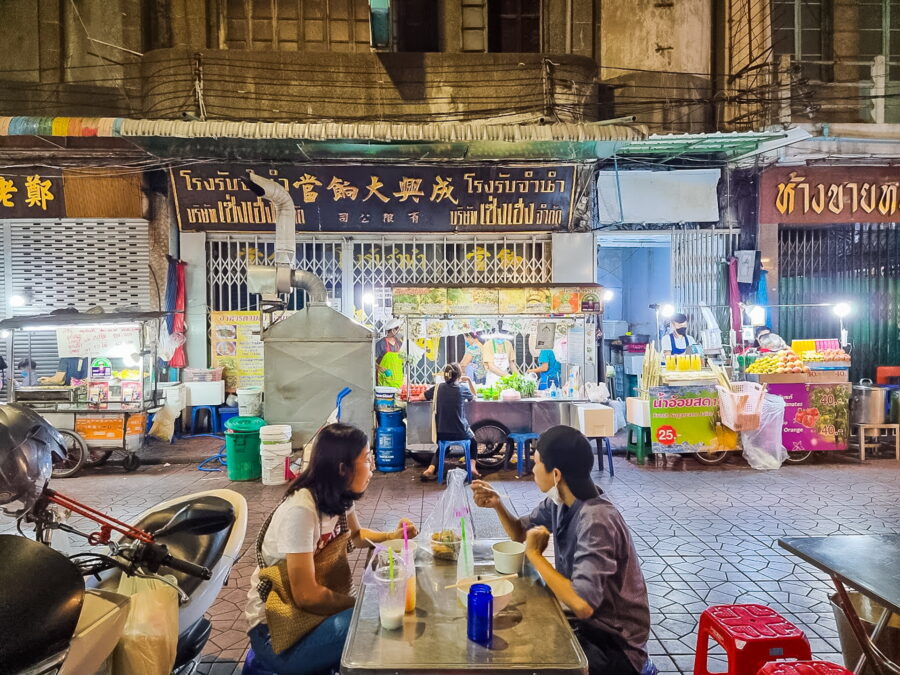
Local restaurants
• Bang Rak district (Saphan Taksin station) → Good concentration of small Thai restaurants.
• Samsen Soi 4 (Old Town) → Nice area with several local options.
➜ Favorite: The Island Restaurant Thai food & Vegetarian and Bar.
• Original Pad Kra Pao 1993 → A cult address. Prepares Pad Kra Pao the old-fashioned way, well-spiced, with real holy basil. Be careful, it can be very spicy if you don't specify!
Fine dining
• Ruen Urai → Hidden away next to Silom, elegant yet affordable, fine Thai cuisine in a traditional house.
• Jim Thompson – A Thai Restaurant → Next to Jim Thompson House. Limited but very good card, it has moved upmarket since its last renovation because before I would not have put it in the "refined" category.
• Blue Elephant (untested) → Gastronomic institution in Sathorn, known for its renowned cooking school.
• Royal Osha (untested) → A stone's throw from Lumphini Park, renowned for its elegant presentations.
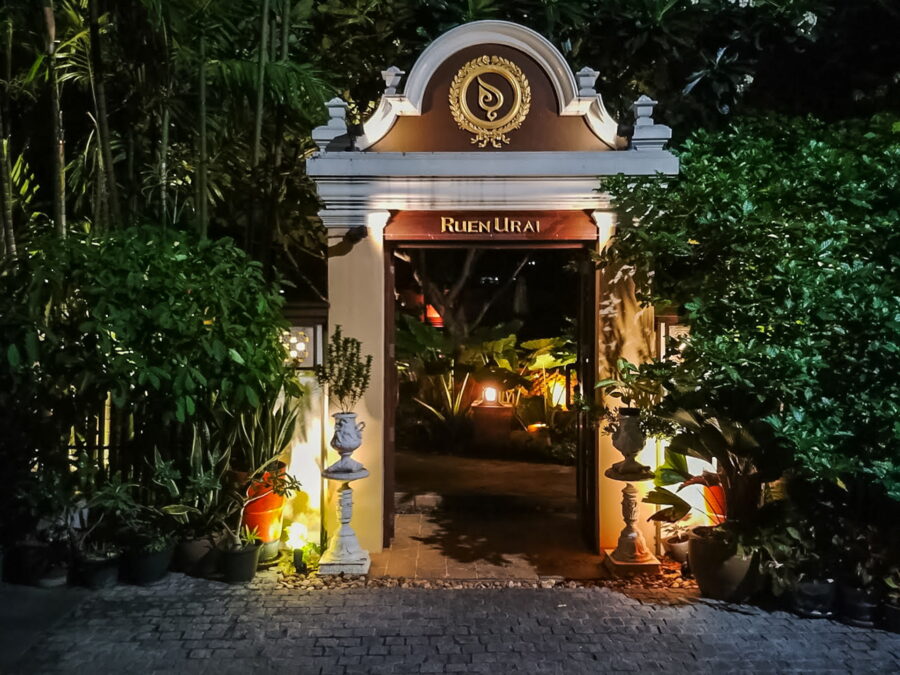
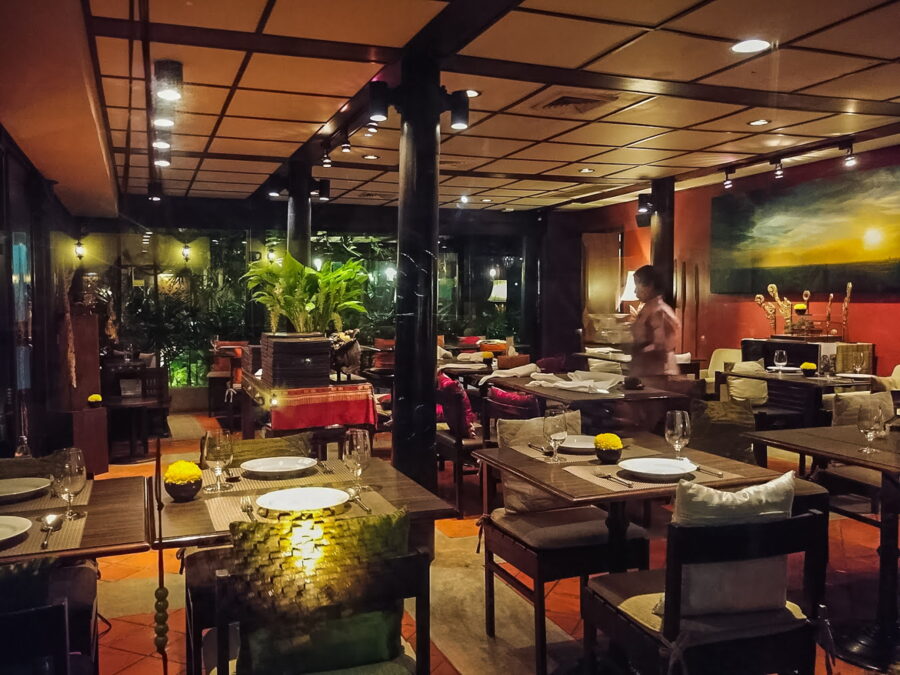
Desserts
• Kor Panich → Renowned as one of the best in the capital.
• The Gingerbread House → Pretty old house, good Thai desserts, ideal for a sweet break.
Chiang Mai
Street food
• Chiang Mai Gate Market (mnight arches) → For kebabs, roti, spicy salads and typical desserts.
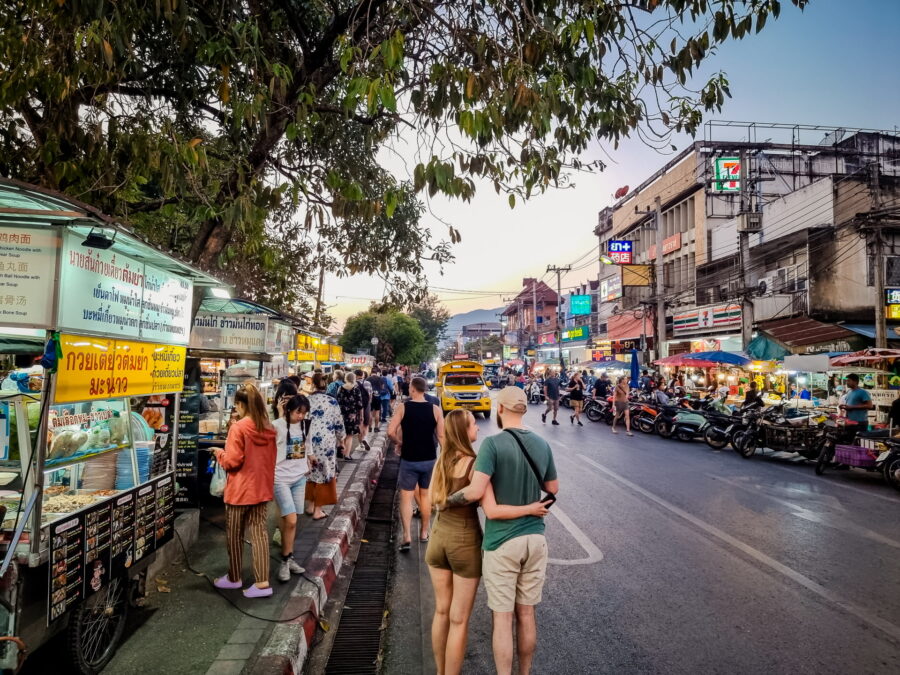
Local restaurants
• Khao Soi Mae Sai → One of the best addresses for this emblematic dish of the North.
• Kat's Kitchen → Varied cuisine and always busy, a good sign!
Fine dining
• The FACES Gallery & Gastro Bar → It's not haute cuisine as such but it's well presented and the setting is great so given the price range, affordable but clearly not "local", it deserves its place here.
Lampang
• Khanom Jeen Pa Bunsri (ขนมจีนป้าบุญศรี) → A killing for the very local Khao Soi, at the entrance to the old street Talat Kao.
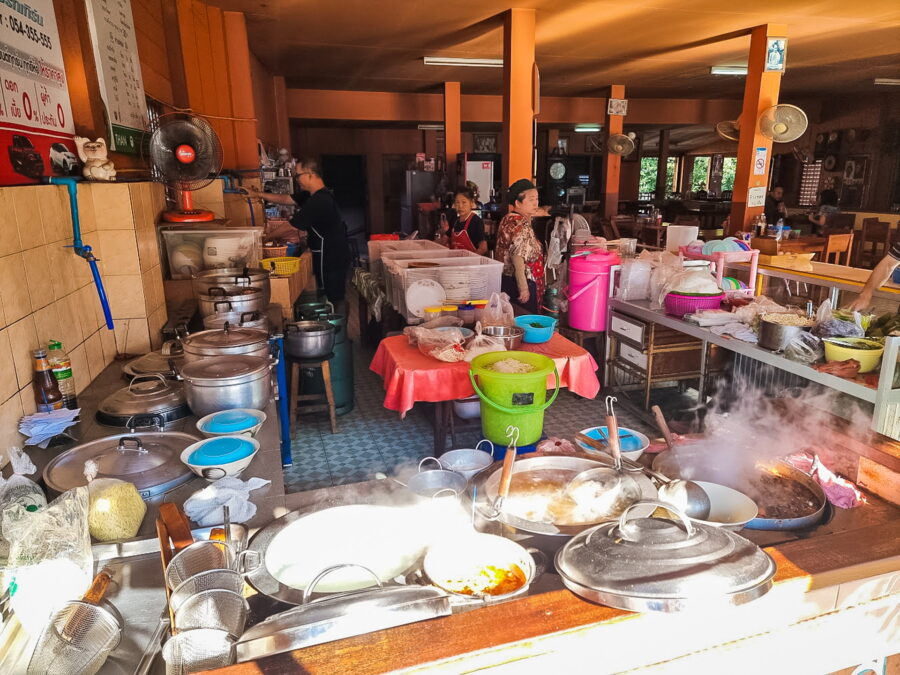
Koh Lanta
• Chef Chalong Restaurant → For a massaman curry perfectly executed (and many other tasty dishes).
Phuket
Street food
• Lock Tien Food Court (Phuket Town) → Authentic and affordable, perfect for tasting local specialties: Hokkien Mee, Satay, yellow curry…
Local restaurants
• โกต้าข้าวมันไก่ (Phuket Town) → If you want to taste an excellent Khao Man Gai.
• Raya Restaurant (Phuket Town) → Traditional cuisine in a beautiful wooden house. Very famous for its southern dishes, especially yellow curries or crab curry with rice noodles.

Fine dining
• Blue Elephant (Phuket Town) → Chic version of Thai cuisine in a colonial setting.
➜ To try well-presented curries or dishes inspired by royal cuisine.
All over Thailand
Mo Ping
• From the morning, in front of the 7/11 or along the sidewalks: no need for an address, just follow the smell of barbecue.
Wheels
You will come across them almost everywhere during your stay; they are often present near tourist sites.
• Opposite Wat Pho (Bangkok) → A little lady always present, success guaranteed.
• At the entrance to the Night Bazaar (Chiang Rai) → Good spot for a banana-chocolate crepe in the evening.
7️⃣ Meals in Thailand: How it works and best practices
Eating in Thailand is not just about discovering flavors, it is also about adapting to cultural habits. very different from those we know in France.
That said, here, eating remains a simple, spontaneous, and convivial act. There's no need to follow strict rules, but knowing these few codes can help you avoid misunderstandings... and make you more comfortable.
No chopsticks?
Contrary to what some travelers think, Thai people don't eat with chopsticks…except for Chinese-inspired noodle soups (like Kuay Teow).
In most cases:
- The spoon is the main utensil for bringing rice and food to the mouth.
- The fork used to push food into the spoon, but never to prick.
- The knife is missing, because the meat is usually already cut into pieces.
At any time… but not always in the same place
In Thailand, we eat at any time of the dayNo need to wait until noon or 19 p.m. There's always a stand or restaurant open somewhere. There aren't really set meal times.
Many restaurants open at dawn to serve workers, while night markets take over in the afternoon until late evening. And if there's a lull at any time, there's always a 7-Eleven (Seven), open 24/24.
The dishes don't arrive at the same time
It's a habit to get into: in Thailand, the dishes are served as soon as they are ready, without waiting for everyone to be served.
It's therefore common to see your neighbor already eating while you're still waiting for your plate. Don't panic: here, no one waits to start, and no one will mind if you do the same.
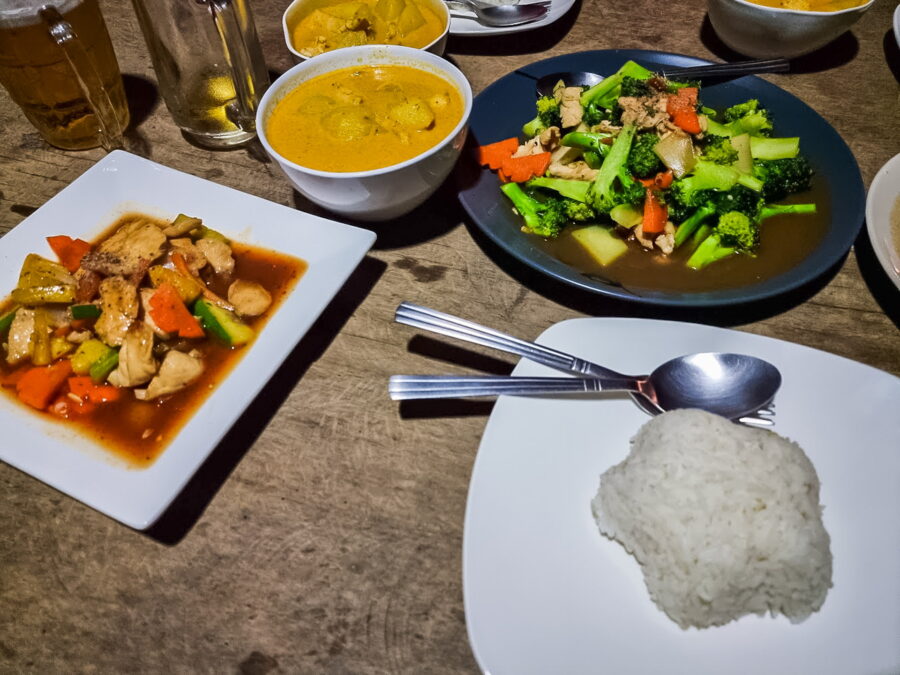
Taxes and tips in Thailand
Here are some things to know before paying the bill:
✔️ Taxes and service charges
- In street restaurants and small shops, the price displayed is the final price.
- In some higher-end restaurants, additional charges may apply:
- 10% service charge
- and sometimes in addition, 7% VAT
These amounts are not not always included in the prices displayed on the menu, so the bill can be surprising. Look carefully at the bottom of the page, it's often written in very small print.
✔️ Should I leave a tip?
Tipping is not mandatory. But if you liked the service, you can round up the bill or leave 10 to 20 baht on your way out—a small gesture that's always appreciated.
Some useful words in Thai
Small note: Polite expressions change according to gender: "Krap" for a man, "Kâa" for a woman.
| French | Thai (translit.) | Pronunciation |
|---|---|---|
| Not spicy | May phet | "Mai farts" |
| Delicious | Stream | "Aroi" |
| The check, please | Check bin | "Tchèk-bine" Krap/Kâa |
| Thank you | Khop khun | "Khòp koun" Krap/Kâa |
| Chicken | Gai | “Kaï” (the G is halfway between G and K) |
| Hog | Moo | "Soft" |
| Rice | Khao | "Khao" |
| Water | Male | "Nâam" |
| Hot | Ron | "Ron" (as in Ron Weasley) |
| Cold | Yen | “Yèn” (as in Cheyenne) |
8️⃣ My tips for eating well in Thailand
Traveling to Thailand means indulging in an avalanche of flavors... as long as you don't miss out on a few best practices. Here are some tips for making the most of the local cuisine.
Don't be afraid of street food
Some travelers are hesitant to eat on the street for fear of unsanitary conditions. Yes, some stalls may seem a little rustic, even "rootsy," but that's often where you'll find the best food.
A restaurant with no decor or a basic-looking stand can hide a real culinary gem. It's not always the case, but it's worth a try! Thailand is often the opposite of the Instagram-friendly plate: what doesn't look like much sometimes explodes in your mouth.
Trust your nose…and returning customers.
Example: Many of the best “Kuay Teow” (noodle soups) or Amazing Pad Kra Pao are served in small eateries open to the street.
Watch out for the chili!
What doesn't sound spicy... can actually be a real challenge for your palate!
If you are sensitive, ask “May phet” (not spicy). And even then… it might be medium-spicy for them! For zero spice, ask for “May sai prik” (no chili at all).
Get out of your comfort zone
Dance very touristy areas, some restaurants Westernize their dishes and inflate their prices. For authentic Thai cuisine, look for restaurants frequented by locals. A menu scribbled in Thai is often a good sign!
And remember: every region has its own specialties. Take advantage of your stay to try something other than the usual Pad Thai.
One of the best ways to discover local gastronomy? Share several dishes at the table: a curry, a salad, a stir-fry… with rice, it’s the winning combo.
Don't hesitate to try the local drinks
Given the heat, cold drinks are an integral part of the dining experience. You'll find:
- Local beers (Singha, Leo, Chang), perfect on the terrace.
- Le cha yen : orange/brown iced tea with condensed milk, very sweet but refreshing.
- Smoothies prepared to order, with or without yogurt/milk (which can be plant-based).
- Coffee, which they prefer iced by default ➜ If you want it hot, it’s better to specify “hot coffee”.
And what about ice cubes?
Don't panic: they're made in a factory using treated water. Industrial ice cubes have a cylindrical shape with a hole in the middle—this is your guarantee that they're clean.
Finally, don't hesitate to test the freshly squeezed fruit juice, sold in small bottles, often prepared before your eyes. Perfect for a sweet and refreshing break.
Did you like the article? share on Pinterest!
